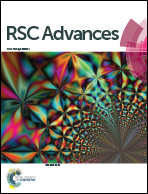Role of iron oxidation byproducts in the removal of phosphate from aqueous solution†
Abstract
Zero Valent Iron (ZVI) is widely investigated in water treatment processes; the removal of contaminants may take place at the surface of ZVI or at the surface of its oxidation byproducts that have flaked off into the bulk solution. In this work, iron byproducts were synthetized under different aeration conditions (4 or 8 mg O2 per L) and aging times (40 h or 6 days). The prepared iron oxidation byproducts were characterized using X-ray diffraction (XRD), Fourier transform infrared (FTIR), Raman spectroscopy, zeta potential, BET surface area, and particle size analyses. XRD analysis showed that the prepared iron oxidation byproducts were composed mostly of lepidocrocite, maghemite, and magnetite. These flaked off iron oxidation byproducts were used alone (without ZVI) to remove phosphate. Equilibrium and kinetic studies were conducted to determine the sorption capacities and the rate of phosphate ion uptake at various pH values by the prepared byproducts. The experimental data showed that phosphate sorption adhered to a pseudo second order kinetic model and the maximum sorption capacity was determined at 2.5 mg P per g. Phosphate removal capacities of synthetic pure iron oxides and oxy-hydroxides were also determined. Raman and FTIR spectroscopy showed that phosphate was retained by inner sphere complexation.


 Please wait while we load your content...
Please wait while we load your content...